
Pityrodia augustensis, commonly known as Mount Augustus foxglove, is a flowering plant in the mint family Lamiaceae and is endemic to a small area in Western Australia. It is a small, bushy shrub with its branches, leaves and some of its flower parts densely covered with woolly hairs. It is similar to the lovely foxglove and the sandplain foxglove but has very different leaves from those species.
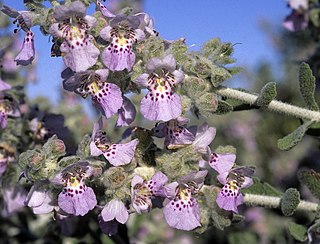
Quoya atriplicina, commonly known as saltbush foxglove, is a flowering plant in the mint family Lamiaceae and is endemic to Western Australia. It is a bushy shrub with its branches and leaves densely covered with a layer of hairs, giving them a greyish appearance. The leaves are broad-elliptic to almost circular in shape and the tube-shaped flowers are pink with purple spots inside.

Quoya oldfieldii, commonly known as Oldfield's foxglove, is a flowering plant in the mint family Lamiaceae and is endemic to the south-west of Western Australia. It is an erect shrub with its branches and leaves densely covered with a layer of brownish hairs. The leaves are egg-shaped and the tube-shaped flowers are pink with purple spots inside.
Dasymalla chorisepala is a flowering plant in the mint family Lamiaceae and is endemic to Western Australia and the Northern Territory. It is a small shrub with its branches and leaves densely covered with hairs. The leaves are stalkless, egg-shaped and covered with yellowish hairs while the flowers are small, tube-shaped and white.

Pityrodia loricata is a flowering plant in the mint family Lamiaceae and is endemic to Australia. It is a dense, greyish, multi-stemmed shrub with whorled leaves, prominent sepals and pale, pinkish-white flowers. It is common in Western Australia and the Northern Territory and there is a single record from South Australia.
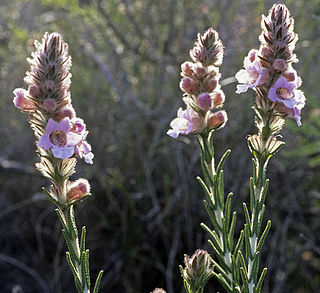
Hemiphora bartlingii, commonly known as woolly dragon, is a flowering plant in the mint family Lamiaceae and is endemic to the south-west of Western Australia. It is an erect shrub with branches covered with greyish, rusty-coloured hairs, leaves with a blistered appearance and with white, pink or purple flowers over an extended period.

Quoya cuneata is a flowering plant in the mint family Lamiaceae and is endemic to the south-west of Western Australia. It is a spreading shrub with its branches and leaves covered with a layer of woolly, pale white or brownish hairs. The flowers are blue at first but become white with purple spots inside the petal tube.
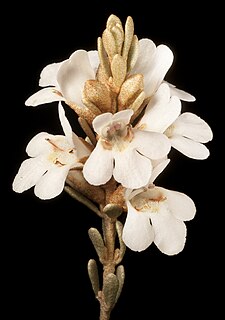
Pityrodia lepidota is a flowering plant in the mint family Lamiaceae and is endemic to the south-west of Western Australia. It is a small, densely-branched shrub with small leaves and whitish, bell-shaped flowers. The entire plant, apart from the petals, is densely covered with small, circular scales.

Hemiphora elderi, commonly known as red velvet, is a flowering plant in the mint family Lamiaceae and is endemic to the south-west of Western Australia. It is a small shrub with its leaves densely covered with white, woolly hairs and with small clusters of reddish-purple, bell-shaped flowers.

Quoya dilatata is a flowering plant in the mint family Lamiaceae and is endemic to Western Australia. It is a low, spreading shrub with its branches and leaves densely covered with a layer of white, woolly hairs. The leaves are wrinkled or crinkly and the tube-shaped flowers are orange-red and hairy on the outside.

Pityrodia chrysocalyx is a flowering plant in the mint family Lamiaceae and is endemic to the south-west of Western Australia. It is an erect, bushy shrub with small, glossy leaves, and flowers with white petals and a golden-yellow calyx.
Muniria megalophylla is a flowering plant in the mint family Lamiaceae and is endemic to Arnhem Land in the Northern Territory. It is a shrub with its branches and leaves densely covered with a layer of short, greyish, branched hairs and small groups of reddish-pink flowers near the ends of the branches.
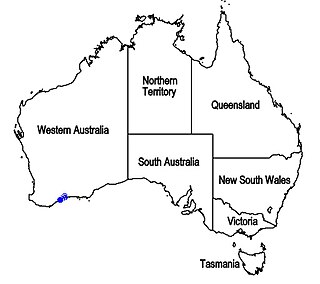
Hemiphora exserta is a flowering plant in the mint family Lamiaceae and is endemic to the south-west of Western Australia. It is a sprawling shrub with its branches densely covered with white, woolly hairs. Its leaves are rough and wrinkled and the flowers are deep pink or dark red, curved and tube-shaped with spreading petal lobes on the end.
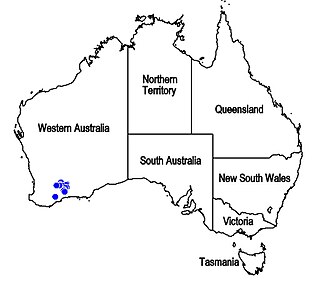
Hemiphora lanata is a flowering plant in the mint family Lamiaceae and is endemic to the south-west of Western Australia. It is a sprawling shrub with its branches and leaves densely covered with white, woolly hairs and with deep pink or dark red, curved, tube-shaped flowers with spreading petal lobes on the end. It is similar to Hemiphora exserta except for its cottony leaf-covering and its longer stamens.

Hemiphora uncinata is a flowering plant in the mint family Lamiaceae and is endemic to the south-west of Western Australia. It is an erect, spreading shrub with its branches densely covered with white, woolly hairs. Its leaves are rough and wrinkled and the flowers are tube-shaped with deep pink petals with wavy edges.

Pityrodia hemigenioides is a flowering plant in the mint family Lamiaceae and is endemic to the south-west of Western Australia. It is a spreading shrub with densely hairy branches and leaves, and pale white flowers near the ends of the branches.

Pityrodia iphthima is a flowering plant in the mint family Lamiaceae and is endemic to a small area in Western Australia. It is a small shrub with its branches, leaves and some of its flower parts densely covered with matted hairs. It has spike-like groups of up to forty flowers on the ends of the branches, the flowers tube-shaped, deep lilac and white, with brown spots inside.

Pityrodia salvifolia is a flowering plant in the mint family Lamiaceae and is endemic to Queensland. It is an erect, spreading shrub with aromatic, wrinkled or corrugated leaves and clusters of small flowers with white petals. It is mostly found in wet forests in coastal north Queensland.

Quoya verbascina, commonly known as golden bush, is a flowering plant in the mint family Lamiaceae and is endemic to Western Australia. It is an erect shrub with its branches and leaves densely covered with woolly hairs. The leaves are often oblong but very variable in shape and the flowers are pinkish-white with pink spots inside and are surrounded by yellow woolly sepals.

Pityrodia obliqua is a flowering plant in the mint family Lamiaceae and is endemic to the Kimberley region of Western Australia. It is an erect shrub with hairy stems, wrinkled, egg-shaped leaves and pink, bell-like flowers with purple streaks inside.



















